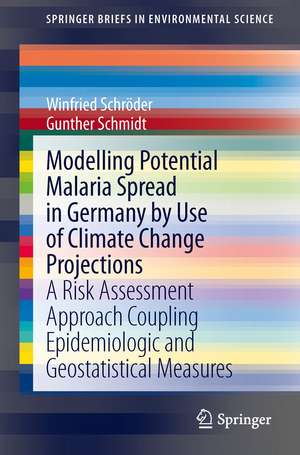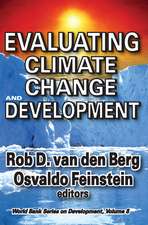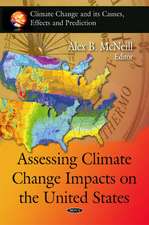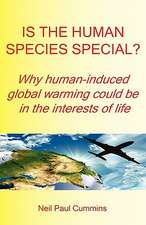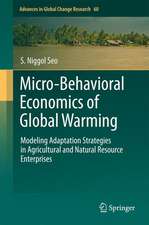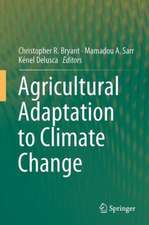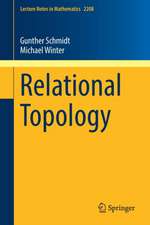Modelling Potential Malaria Spread in Germany by Use of Climate Change Projections: A Risk Assessment Approach Coupling Epidemiologic and Geostatistical Measures: SpringerBriefs in Environmental Science
Autor Winfried Schröder, Gunther Schmidten Limba Engleză Paperback – 8 ian 2014
Din seria SpringerBriefs in Environmental Science
-
 Preț: 348.77 lei
Preț: 348.77 lei -
 Preț: 382.57 lei
Preț: 382.57 lei -
 Preț: 378.12 lei
Preț: 378.12 lei -
 Preț: 378.80 lei
Preț: 378.80 lei -
 Preț: 381.98 lei
Preț: 381.98 lei -
 Preț: 347.80 lei
Preț: 347.80 lei - 15%
 Preț: 464.18 lei
Preț: 464.18 lei -
 Preț: 378.12 lei
Preț: 378.12 lei -
 Preț: 377.53 lei
Preț: 377.53 lei -
 Preț: 379.09 lei
Preț: 379.09 lei -
 Preț: 381.00 lei
Preț: 381.00 lei -
 Preț: 383.93 lei
Preț: 383.93 lei -
 Preț: 175.58 lei
Preț: 175.58 lei -
 Preț: 475.83 lei
Preț: 475.83 lei -
 Preț: 380.07 lei
Preț: 380.07 lei -
 Preț: 378.92 lei
Preț: 378.92 lei -
 Preț: 411.93 lei
Preț: 411.93 lei -
 Preț: 375.62 lei
Preț: 375.62 lei -
 Preț: 375.45 lei
Preț: 375.45 lei -
 Preț: 378.92 lei
Preț: 378.92 lei -
 Preț: 377.57 lei
Preț: 377.57 lei -
 Preț: 377.35 lei
Preț: 377.35 lei -
 Preț: 378.34 lei
Preț: 378.34 lei -
 Preț: 344.67 lei
Preț: 344.67 lei -
 Preț: 362.43 lei
Preț: 362.43 lei -
 Preț: 446.26 lei
Preț: 446.26 lei - 5%
 Preț: 361.96 lei
Preț: 361.96 lei -
 Preț: 376.43 lei
Preț: 376.43 lei -
 Preț: 380.63 lei
Preț: 380.63 lei -
 Preț: 375.84 lei
Preț: 375.84 lei - 15%
 Preț: 463.20 lei
Preț: 463.20 lei -
 Preț: 383.33 lei
Preț: 383.33 lei -
 Preț: 375.23 lei
Preț: 375.23 lei -
 Preț: 377.57 lei
Preț: 377.57 lei -
 Preț: 381.59 lei
Preț: 381.59 lei -
 Preț: 379.48 lei
Preț: 379.48 lei -
 Preț: 376.04 lei
Preț: 376.04 lei -
 Preț: 413.84 lei
Preț: 413.84 lei -
 Preț: 381.81 lei
Preț: 381.81 lei -
 Preț: 352.28 lei
Preț: 352.28 lei -
 Preț: 381.81 lei
Preț: 381.81 lei -
 Preț: 381.98 lei
Preț: 381.98 lei - 5%
 Preț: 331.65 lei
Preț: 331.65 lei -
 Preț: 375.62 lei
Preț: 375.62 lei -
 Preț: 377.95 lei
Preț: 377.95 lei -
 Preț: 413.45 lei
Preț: 413.45 lei -
 Preț: 267.16 lei
Preț: 267.16 lei -
 Preț: 373.72 lei
Preț: 373.72 lei -
 Preț: 375.62 lei
Preț: 375.62 lei
Preț: 374.30 lei
Nou
Puncte Express: 561
Preț estimativ în valută:
71.62€ • 75.03$ • 59.36£
71.62€ • 75.03$ • 59.36£
Carte tipărită la comandă
Livrare economică 08-22 aprilie
Preluare comenzi: 021 569.72.76
Specificații
ISBN-13: 9783319038223
ISBN-10: 3319038222
Pagini: 68
Ilustrații: VIII, 58 p. 18 illus., 15 illus. in color.
Dimensiuni: 155 x 235 x 4 mm
Greutate: 0.09 kg
Ediția:2014
Editura: Springer International Publishing
Colecția Springer
Seria SpringerBriefs in Environmental Science
Locul publicării:Cham, Switzerland
ISBN-10: 3319038222
Pagini: 68
Ilustrații: VIII, 58 p. 18 illus., 15 illus. in color.
Dimensiuni: 155 x 235 x 4 mm
Greutate: 0.09 kg
Ediția:2014
Editura: Springer International Publishing
Colecția Springer
Seria SpringerBriefs in Environmental Science
Locul publicării:Cham, Switzerland
Public țintă
GraduateCuprins
1. Background and Goals.- 2. Case Study 1: Modelling Potential Transmission Gates of Malaria Tertiana in Lower Saxony.- 3. Case Study 2: Modelling Potential Transmission Gates of Malaria Tertiana in Germany.- 4. Conclusions and Outlook.
Textul de pe ultima copertă
One of the most troubling and dangerous effects of climate warming is the potential for new outbreaks of vector-borne diseases – in humans as well as livestock – that had previously been eradicated, or at least effectively suppressed. One such threat is malaria. Although it is often believed to be restricted to the tropics and developing countries, climate change could bring malaria back to Europe, especially into countries where it was present until the middle of the last century, such as Germany, where Tertian malaria or vivax malaria, a rather severe form of malaria, was prevalent in north-western parts of the country until the 1950s, when it was eradicated. The vector itself, the mosquito (Anopheles atroparvus), is still present, and infected people from malarial regions could introduce a new onset of malaria.
This book investigates the spatial distribution of potential temperature-driven malaria transmissions, using the basic reproduction rate (R0) to model the reproduction of the malaria pathogen Plasmodium vivax. The authors mapped areas at risk of an outbreak of tertian malaria in the federal state of Lower Saxony (pre-study) and for whole Germany (main-study) by means of geostatistics for past (1947-2007) and future periods. Projections based on predicted monthly mean air temperature data derived from the IPCC and regionally discriminated by two regional climate models (REMO, WettReg) for the countrywide study.
The transmitted parasites usually benefit from increased temperatures as both their reproductive and development cycles are accelerated. The resulting maps show that the seasonal transmission gate may be extended from an average of 3 months under present temperature conditions to up to 6 months in the climate reference period 2051-2080. Although models described in this book do not integrate such other driving factors as the distribution of water bodies serving as breeding habitats, or population density, the findingsilluminated here could prove useful for establishing a monitoring scheme and for investigation and assessment of related diseases caused by temperature-dependent vectors and pathogens, including many which are dangerous for livestock.
This book investigates the spatial distribution of potential temperature-driven malaria transmissions, using the basic reproduction rate (R0) to model the reproduction of the malaria pathogen Plasmodium vivax. The authors mapped areas at risk of an outbreak of tertian malaria in the federal state of Lower Saxony (pre-study) and for whole Germany (main-study) by means of geostatistics for past (1947-2007) and future periods. Projections based on predicted monthly mean air temperature data derived from the IPCC and regionally discriminated by two regional climate models (REMO, WettReg) for the countrywide study.
The transmitted parasites usually benefit from increased temperatures as both their reproductive and development cycles are accelerated. The resulting maps show that the seasonal transmission gate may be extended from an average of 3 months under present temperature conditions to up to 6 months in the climate reference period 2051-2080. Although models described in this book do not integrate such other driving factors as the distribution of water bodies serving as breeding habitats, or population density, the findingsilluminated here could prove useful for establishing a monitoring scheme and for investigation and assessment of related diseases caused by temperature-dependent vectors and pathogens, including many which are dangerous for livestock.
Caracteristici
Offers a sophisticated risk assessment approach which links epidemiological and geostatistical measures Applies regional temperature projections to research on the impacts of climate change Shows how modeling can help to identify areas at risk in an epidemiological context with the aim of initiating preventative measures Includes supplementary material: sn.pub/extras
